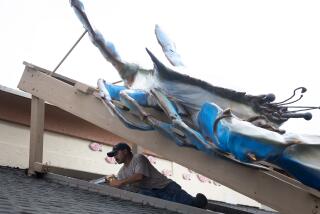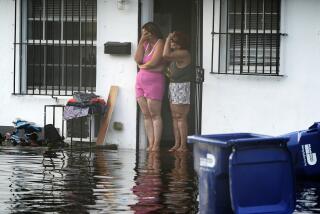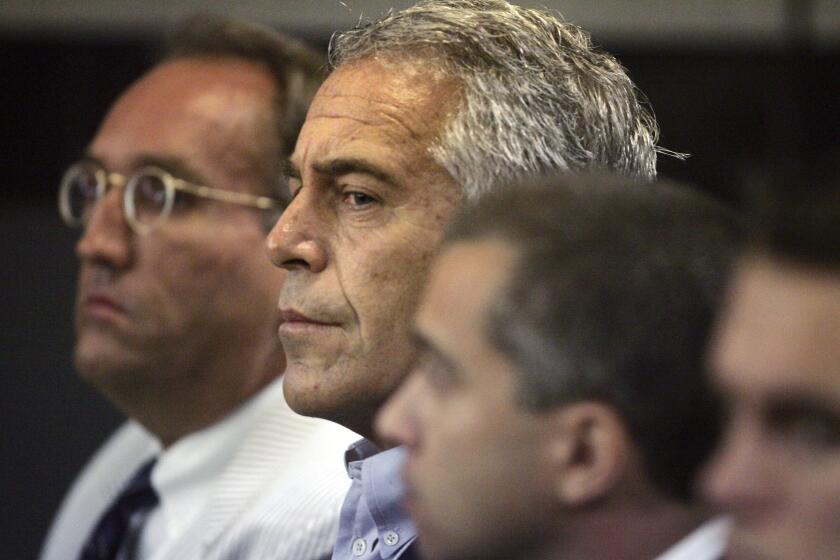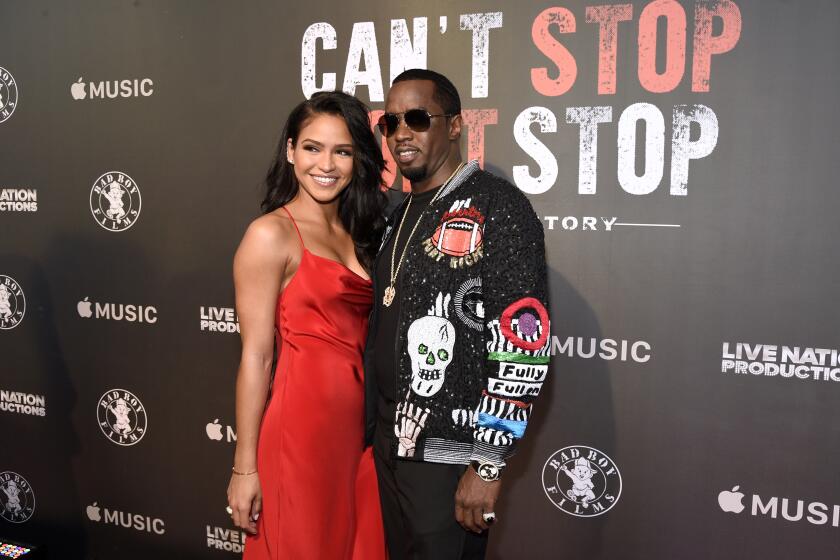After the Flush of Relief, Area Goes on Guard
- Share via
MIAMI — The initial feelings of relief and euphoria that followed southern Florida’s survival of Hurricane Andrew quickly transformed Monday into roadblocks, barricades and curfews.
In the early morning aftermath, the 4 million people who lived through the terror of five hours of 160-m.p.h. winds and 12-foot sea surges emerged to find extensive property damage but far fewer deaths and injuries than expected.
“It’s a mess,” said Miami Beach Mayor Seymour Gelmar, “trees littering, lines down, but on the whole we’re in pretty good shape. We won’t have a tennis tournament this afternoon but in four hours we’ll be back to being Miami Beach again.”
At first blush, that sense of determined optimism showed up throughout the region. People more strangers than neighbors joined together to clear debris. Volunteers flocked to the 40 Miami shelters and relief workers sought out the dozens of homeless men who refused to evacuate their cardboard village two blocks from downtown Miami’s bay front--and survived the storm.
“These events bring people together,” said Roger Clark of Coral Gables, a wealthy in-town suburb hard hit by the hurricane. “I’ve never really talked to my next-door-neighbor before, but he came over first thing to help” clean up the mess left by two uprooted trees and a crushed car.
There were many similar scenes as a reporter, riding a bicycle because a car could not get through, zigzagged along the path that Andrew carved through Coral Gables.
People set up a sort of bucket brigade, passing broken tree limbs and chain-sawed logs hand to hand to clear streets and lots. In commercial areas, employees and shop owners joined together to clear the sidewalks of shattered window glass.
But what seemed to mark Miami more as the wind diminished and the water receded were sirens, police cars, barricades and troops carrying loaded assault rifles.
Some 1,500 of the flack-jacketed National Guard troops rolled into downtown Miami at midday, leaping from their trucks and carrying ready-to-shoot M-16 rifles.
They joined riot-equipped police in setting up barricades around the area’s most prominent commercial areas, downtown Miami and Coconut Grove, both of which border on two of the city’s poorest and most volatile black neighborhoods.
Far from those violence-prone areas, police blocked off access to the rich and flamboyant Miracle Mile, the main shopping street for Coral Gables. “We just don’t want people around,” said one Coral Gables police officer, who kept his badge out of view.
To ensure that people, in the words of Patrick Brinkman, a Metro-Dade police sergeant, “stay the hell off the streets,” Dade County officials ordered a 7 p.m. to 7 a.m. curfew that will last indefinitely.
The official reasons for placing the Miami area under near martial law is to keep the streets clear for emergency workers and police. That is why, said an aide to the Miami Beach mayor, “we closed the island to non-residents. We just had to give the (emergency) workers the space and peace to work.”
The same reason came for closing the only bridge linking Miami and the opulent village of Key Biscayne. “There’s just not enough room for the damage assessors, the cleanup crews and the repair people if we let people go there,” said a spokeswoman at the Miami-Dade Emergency Center.
But police officials had a darker view, citing the large number of cars cruising through the city’s littered and broken streets, some merely sightseeing but others suspected of casing potential looting targets.
“Hardly any of the people we stop trying to get into downtown (Miami) or Coconut Grove work there,” said a motorcycle officer whose ID read Garcia. “Nobody’s working today and they shouldn’t be driving around.”
There was some justification for that suspicion. Shops at the rundown and inexpensive Cutler Ridge Mall were threatened by as many as 100 looters, police said.
Isolated groceries and other small shops throughout the region were hit by looters, often as television crews filmed their activities. Some of the robberies seemed more for the thrill or experience than to satisfy any need. At one variety store, four young men ran away toting cartons of disposable diapers.
To some experts, the reason for aggressive police action to restrain the public really lies in the less easily seen effects of Hurricane Andrew. It’s not the uprooted trees, wrecked shoreline or even the hundreds of thousands of damaged homes that make for trouble, one veteran policeman said.
“People are desperate, crying for help,” said Brinkman. “They are cooperating now because they are pretty much in shock. But what happens in two or three days, what happens when the people are still without water and electricity?”
That is a real possibility. Utility officials cut off a large section of Miami’s water supply because of sewage treatment problems. Gas and electricity for more than 1 million people also were shut off, either by the storm or by public officials worried about the potential for fire or injury.
Gas stations cannot operate, the airport is closed at least until tonight and grocery stores, overrun by hurricane demand before the storm hit, are not restocked.
Public and utility officials say that it will take time, a lot of it, to reach anything resembling normalcy. Florida Power & Light officials said it would take from three days to three weeks to restore electricity, pointing to the 17 days power was off when Hurricane Hugo struck South Carolina in 1989.
“And Hugo was in a far less densely populated area,” said one utility official. “I hope we do better, but privately I doubt it.”
How to Help
The following organizations have set up relief funds for victims of Hurricane Andrew:
The American Red Cross
P.O. Box 37243
Washington, D.C. 20013
(make checks payable to the American Red Cross and earmark them for hurricane relief)
Credit-card donations may be telephoned to 1-800-842-2200 or, for those seeking Spanish-speaking operators, to 1-800-257-7575.
Disaster Response Catholic Charities USA
1731 King St. 200
Alexandria, Va. 22314
(make checks payable to Catholic Charities USA--Disaster Response)
Storm’s Next Target
The forecast is for Andrew to charge up the Gulf and crash into southeast Louisana. Here are calculations of the likelihood that Hurricane Andrew will hit various locations. New Orleans: 21% Gulfport, Miss.: 19% Galveston, Tex.: 15% Panama City, Fla.: 11% Corpus Christi, Tex.: 7% Location as of 11 p.m. EDT: About 350 miles southeast of New Orleans Winds: 140 m.p.h. Storm direction: West-northwest at 18 m.p.h.
Source: WeatherData, Inc., National Weather Service
More to Read
Sign up for Essential California
The most important California stories and recommendations in your inbox every morning.
You may occasionally receive promotional content from the Los Angeles Times.













